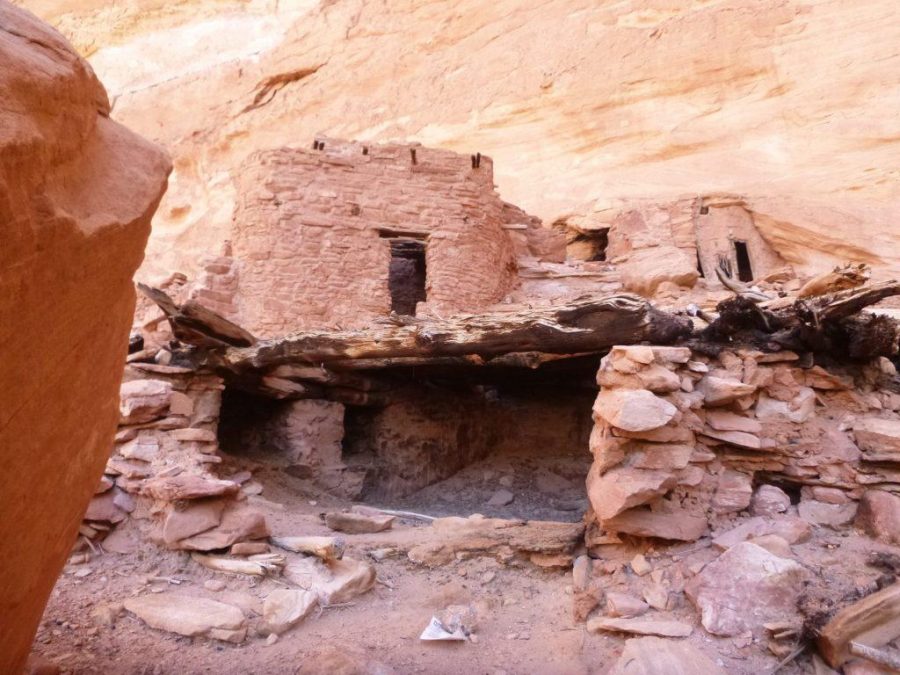As the sun begins to sneak around the desert varnished canyon wall, I roll over in my sleeping bag and catch a sight of the Jailhouse Ruin. Over the past couple of days, my eyes have adjusted to spotting stacked stones and rectangular openings wedged between sandstone shelves. These were the ancient homes of the Anasazi, and they sit hidden in the Cedar Mesa region waiting to be discovered.
To celebrate the end of finals, my friends and I tossed a few days worth of food and gear into backpacks, jumped into our Subaru Outback and drove south. We chose the 23 mile Grand Gulch to Bullet Canyon loop, tucked in the valley of national parks and monuments in southeastern Utah.
The trail leads you into the past, revealing dozens of Anasazi cliff dwellings as it meanders through canyons, paralleling streams and dry riverbeds. It is a diverse trail, traversing sloping slickrock then winding through thick grass and shrubs that nearly block the trail. But, around practically every corner, it became a game to spot the homes these Native Americans inhabited between 800 and 2,000 years ago. As we tip-toed beneath remnants 75 feet above the canyon floor, we wondered out loud how they could reach their homes and live on the edge of cliffs.
These Anasazi groups were numerous, and their pottery, corn and pictographs are seen all around the canyons. They abandoned this region around 1300 CE and fled south into Arizona and New Mexico. Archaeologists believe the Hopi and Zuni are their modern-day descendants because some traditions, such as holding ceremonies in underground chambers called kivas, are still practiced today.
Signs advising “Show Respect” and “Don’t climb into the homes” sit in most sites, but some are left un-touched, leaving me to feel like a true archaeologist stumbling upon an ancient treasure.
Although we did not run into many hikers on our journey, we met up with a few groups at Jailhouse Ruin on our second and final night. One group of six rugged men who looked like they had explored all of Utah told us this is their favorite trail, though, they worry what the future will bring.
“They’re thinking about naming it a national monument,” they tell us as they gather water from the trickling stream. “Then, it won’t be so secret anymore.”
Establishing the Cedar Mesa area as a monument will help protect the countless archaeological sites, but it may also attract more visitors, meaning highly congested trails and a greater possibility of vandalism.
So, I’d recommend getting out and exploring the ancient past while you can. Zig-zag through fuchsia, burnt orange and lemon yellow wildflowers and you may spot some wildlife as well. Every step on the trail will keep you wondering what more you will uncover, and before you know it the trail leads you up steep slabs of slickrock and you are scrambling over small boulders to finish on flat desert soil. You might just heave a sigh of relief and a groan of resentment as you kick off your shoes, roll the windows down and drive back to civilization. But don’t worry- there are still five hours of riding with a grin on your face before you have to deal with real life again.
Follow Our Lead
Trailhead: across the road from Kane Gulch Ranger Station and is a 23ish mile loop.* *Disclaimer: the trail is not a full loop but ends 8.4 miles up the road. You can shuttle a car to the end of the trail (Bullet Canyon) or do what most hikers do and hitch a ride back on the road.
Trail: gently descends into Grand Gulch. At 3.8 miles, you’ll see the first ruin, Jailhouse Junction. About a mile later, you will run into Turkey Pen Ruin, followed by an un-named ruin tucked into the wall. Todie’s Canyon, where most people camp, is another 2.5 miles along. There are several established campsites, or you can stay at a makeshift one at pour-off pool (1.25 miles from Todie’s) which has a reliable and large water source.
Most of the ruins lie between Todie’s Canyon and Bullet Canyon, so plan for plenty of exploration stops to catch them all the first and second day. Don’t miss Split Level Ruin, a large site with several pictographs. Also, be sure to not to miss the turnoff to Bullet Canyon at mile 14.5. From the split-off, another 2.3 miles along will lead you to Jailhouse Ruin and the perfect kiva, where we camped the second night.
The final trek is about 5 miles out to the trailhead (if you parked your car there) or another mile to the road so you can hitchhike. The final ruins are on your left as you exit Bullet Canyon.
Permits: $8 per person
Contact: Bureau of Land Management, Monticello. (435) 587-2141
Season: Spring and Fall (accessible in the Summer and Winter but temperatures are extreme in the canyon)


